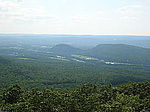St. Stanislaus Bishop & Martyr's Church (South Deerfield, Massachusetts)
1908 establishments in MassachusettsChristian organizations established in 1908Deerfield, MassachusettsPolish-American Roman Catholic parishes in MassachusettsRoman Catholic parishes of Diocese of Springfield in Massachusetts ... and 1 more
United States Roman Catholic church stubs
St. Stanislaus Bishop & Martyr's Church is a church designated for Polish immigrants in South Deerfield, Massachusetts, United States. Founded 1908, it is one of the Polish-American Roman Catholic parishes in New England in the Diocese of Springfield in Massachusetts. The Parish name was changed in 2009 to Holy Family Parish, to accommodate the pastoral planning project of the Bishop of Springfield, Timothy McDonnell.
Excerpt from the Wikipedia article St. Stanislaus Bishop & Martyr's Church (South Deerfield, Massachusetts) (License: CC BY-SA 3.0, Authors).St. Stanislaus Bishop & Martyr's Church (South Deerfield, Massachusetts)
Sugarloaf Street,
Geographical coordinates (GPS) Address Nearby Places Show on map
Geographical coordinates (GPS)
| Latitude | Longitude |
|---|---|
| N 42.475 ° | E -72.604888888889 ° |
Address
Sugarloaf Street 38
01373
Massachusetts, United States
Open on Google Maps










